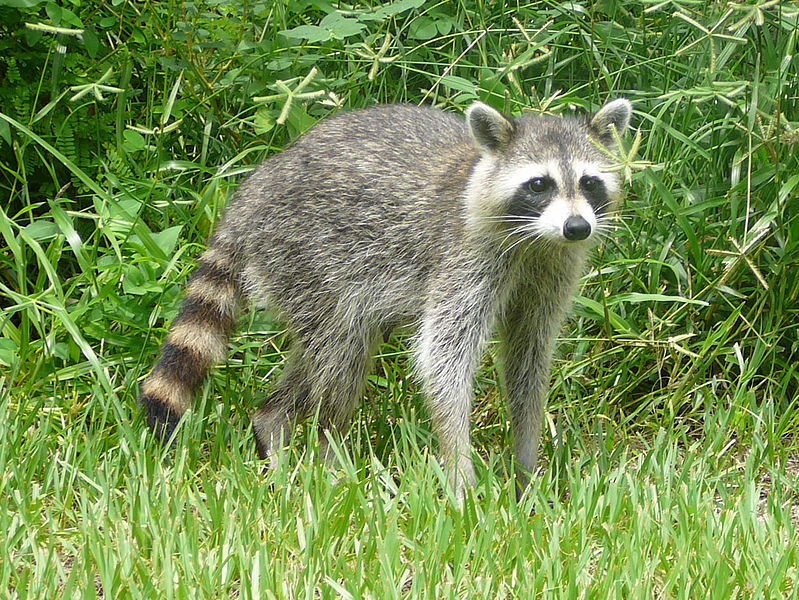At least 10 miles away from your home to prevent them from returning.
So, you’ve got a raccoon problem. Welcome to the club! These furry little bandits can be quite the nuisance, rummaging through your trash, making a racket in the attic, or treating your garden like their personal buffet. But before you lose your cool and start plotting revenge, let’s talk about a more humane and effective solution: relocating them.
Relocating raccoons is not just about getting rid of them it’s about doing so in a way that respects their role in the ecosystem while also ensuring they don’t make a surprise return. Trust me, I’ve been down this road before. I’ve spent many a night researching the best ways to deal with these critters, and I’ve learned a thing or two about what works and what doesn’t.
Why Relocate Raccoons?
Let’s be honest, raccoons are pretty adorable with their masked faces and nimble little paws. But when they start treating your attic like a luxury condo or your trash cans like a 24-hour buffet, the charm quickly wears off. So, why not just call pest control and be done with it? Well, there are several good reasons to consider humane relocation instead.
Firstly, raccoons play a crucial role in our ecosystem. They help control insect populations and disperse seeds, contributing to the health of our natural environment. By relocating them rather than exterminating them, we help maintain this delicate balance.
Secondly, there’s the ethical aspect. Most of us want to handle wildlife conflicts in the most humane way possible. Relocating raccoons gives them a chance to continue their lives without harm, away from human dwellings where they can cause problems.
And let’s not forget the legal considerations. In many areas, it’s actually illegal to kill raccoons due to their protected status. Even if it’s allowed, there are often strict regulations about how it can be done. By opting for relocation, you’re not only doing the right thing but also staying on the right side of the law.
Finally, there’s personal peace of mind. Knowing you’ve handled the situation humanely and responsibly can bring a great sense of satisfaction. I’ve had my fair share of raccoon encounters, and every time I’ve chosen to relocate them, I’ve felt better knowing I did the right thing for both the raccoons and my household.

How Far to Relocate a Raccoon?
So, you’ve decided to relocate your raccoon friend—fantastic! Now comes the million-dollar question: how far is far enough? It turns out, these clever critters have a remarkable homing instinct, so a casual drop-off down the street just won’t cut it.
The golden rule is to relocate raccoons at least 10 miles away from your home. Why 10 miles, you ask? Well, raccoons are known to have strong territorial habits and can navigate their way back to familiar territories from impressive distances. By relocating them at least 10 miles away, you’re giving them a fresh start in a new environment and minimizing the chances of them returning to your property.
But why stop at 10 miles? While 10 miles is generally considered a safe distance, if you live in an area with dense raccoon populations, it might be worth considering an even greater distance. Think about areas with ample natural resources—wooded areas, near water sources, and away from other residential zones. This ensures the raccoon can find food and shelter without the temptation of human dwellings.
I’ve personally relocated raccoons and learned that the effort of a long drive pays off. It might seem like a hassle, but think of it as an adventure—a chance to explore new areas while ensuring your little masked friend has the best chance at a new life. Plus, it’s a small price to pay for the peace of mind that comes from knowing they won’t be making a surprise comeback.
Legal Considerations for Raccoon Relocation
Before you load up that raccoon in your car for a cross-country adventure, it’s crucial to know that relocating wildlife isn’t just about finding a new home for your furry friend—it’s also about staying within the bounds of the law. Here’s what you need to know.
First and foremost, wildlife laws vary widely from state to state, and even within local jurisdictions. Some places have strict regulations on trapping and relocating raccoons due to concerns about disease spread and ecological impact. It’s essential to check with your local wildlife authorities or the Department of Natural Resources (DNR) to understand the specific rules in your area. Ignorance isn’t bliss when it comes to the law!
In many regions, a permit is required to trap and relocate wildlife. This permit ensures that relocations are conducted humanely and that the relocated animals have a good chance of survival in their new environment. Getting a permit might seem like a hassle, but it’s a necessary step to ensure you’re compliant with local wildlife management practices.
Moreover, there are often guidelines on where you can and cannot release raccoons. For instance, releasing them on public lands like parks or nature reserves might be prohibited to prevent overpopulation and competition with existing wildlife. Private lands are usually the go-to, but you’ll need the landowner’s permission. This ensures that the raccoons aren’t inadvertently creating new conflicts in their new location.
Another key point is the health aspect. Raccoons can be carriers of diseases like rabies, and transporting them without proper precautions can pose risks to other animals and humans. Local wildlife authorities can provide guidelines on how to handle and transport raccoons safely, minimizing the risk of disease transmission.
Finally, consider working with a licensed wildlife rehabilitator or removal service. These professionals are well-versed in the legalities and best practices of wildlife relocation. They can ensure that the process is not only legal but also humane and effective. If you’re not comfortable handling the raccoon yourself, this is a great option to consider.
Steps for Safe and Humane Raccoon Relocation
Alright, you’re ready to be a raccoon relocation hero! Here’s a step-by-step guide to ensure the process is as smooth and humane as possible. Remember, the goal is to make this a stress-free experience for both you and the raccoon.
Preparing for Relocation
Before you even think about setting a trap, make sure you have all the necessary equipment. Here’s your checklist:
- Live Trap: Choose a humane live trap that’s large enough for a raccoon. These traps are designed to capture the animal without causing harm.
- Protective Gear: Gloves and long sleeves are a must to protect yourself from scratches and bites. Raccoons, though often shy, can get defensive when they feel threatened.
- Bait: Raccoons are omnivores with a sweet tooth. Marshmallows, fruits, or a can of tuna can work wonders as bait.
Safety first! Ensure the trap is placed in an area where children and pets can’t accidentally trigger it.
Trapping the Raccoon
Now, onto the actual capture. Here’s how to do it right:
- Set the Trap: Place the bait inside and set the trap according to the manufacturer’s instructions. Position the trap in an area where raccoons are known to frequent, such as near trash cans or the attic entrance.
- Check Frequently: Monitor the trap frequently—at least twice a day. You don’t want the raccoon to be stuck in there longer than necessary. Early morning and late evening checks are ideal since raccoons are nocturnal.
Be patient. Sometimes it takes a few days for a raccoon to muster up the courage to enter the trap.
Transporting the Raccoon
Congratulations, you’ve got yourself a raccoon! Now, let’s talk transport:
- Cover the Trap: Once the raccoon is trapped, cover the trap with a blanket or tarp. This helps keep the raccoon calm and reduces stress during transport.
- Secure Transport: Place the covered trap in the back of your vehicle, securing it so it doesn’t move around during the drive. Make sure your vehicle is well-ventilated to keep the raccoon comfortable.
Remember, you’re taking a road trip with a wild animal, so drive cautiously to avoid sudden stops or sharp turns.
Releasing the Raccoon
The final step—freedom!
- Choose the Right Spot: As we discussed, at least 10 miles away from your home, in a suitable habitat like a wooded area far from residential zones. Ensure the area has water sources and natural food supplies.
- Open the Trap: Carefully open the trap and step back. Let the raccoon find its way out on its own. This might take a few minutes as it assesses its new surroundings.
And there you have it! You’ve successfully and humanely relocated a raccoon. Give yourself a pat on the back.
Potential Risks and How to Mitigate Them
While relocating a raccoon is a humane and often effective solution, it’s not without its risks. But don’t worry, with a bit of preparation and awareness, you can minimize these risks and ensure a successful relocation. Here’s what you need to know:
Disease Transmission
Raccoons can carry diseases such as rabies and leptospirosis, which pose risks to both humans and pets. Here’s how to stay safe:
- Wear Protective Gear: Always use gloves and long sleeves when handling the trap and the raccoon to avoid direct contact.
- Minimize Contact: Handle the trap gently and avoid touching the raccoon directly. Keep pets and children away from the trapped raccoon.
If you’re concerned about potential exposure, consult with a local wildlife expert or veterinarian.
Stress and Injury to the Raccoon
Relocation can be a stressful experience for any wild animal, and stress can lead to injury or death if not managed properly.
- Use a Proper Trap: Ensure you’re using a humane live trap that’s appropriately sized for a raccoon. This helps prevent injury.
- Cover the Trap: Once the raccoon is trapped, cover the trap with a blanket or tarp to help keep the animal calm during transport.
Transport the raccoon as quickly and smoothly as possible to reduce the time it spends in the trap.
Environmental Impact
Relocating a raccoon can disrupt the local ecosystem at both the release and capture sites. Here’s how to mitigate these impacts:
- Choose the Right Location: Release the raccoon in a habitat that supports its needs (food, water, shelter) and is away from other human dwellings. Avoid releasing in areas with known endangered species or sensitive ecosystems.
- Monitor the Area: If possible, check back on the release area to ensure the raccoon has adapted well to its new environment. Look for signs that it’s finding food and shelter.
Consult local wildlife authorities to get advice on suitable release locations that minimize ecological disruption.
Legal Risks
As mentioned earlier, there are legal considerations to keep in mind. Here’s how to stay compliant:
- Check Local Regulations: Ensure you’re aware of and following local laws regarding wildlife relocation. This includes obtaining any necessary permits.
- Work with Professionals: If you’re unsure about any aspect of the process, consider hiring a licensed wildlife removal expert. They have the knowledge and experience to handle the relocation legally and humanely.
Document your actions, including permits obtained and guidelines followed, to protect yourself legally.
Tips for Preventing Raccoons from Returning
Now that you’ve successfully relocated your raccoon, it’s time to ensure they don’t come back—or invite their friends over! Here are some effective strategies to raccoon-proof your home and property.
Securing Your Property
Raccoons are clever and persistent, so you’ll need to outsmart them by securing potential entry points and sources of attraction:
- Seal Entry Points: Inspect your home for any openings, including chimneys, vents, and gaps in the roof or siding. Use metal mesh, hardware cloth, or other sturdy materials to seal these gaps.
- Secure Trash Cans: Raccoons love an easy meal, so make sure your garbage is off-limits. Use heavy-duty trash cans with secure lids, or store trash cans in a locked shed or garage.
- Remove Food Sources: Don’t leave pet food outside overnight. If you have bird feeders, consider bringing them in at night or using raccoon-proof designs.
Regularly inspect your property for any new potential entry points or food sources.
Natural Deterrents
Using natural deterrents can help keep raccoons at bay without causing them harm:
- Scents They Dislike: Raccoons have sensitive noses. Ammonia-soaked rags, peppermint oil, or a mixture of water and hot sauce sprayed around your property can deter them. Just be sure to reapply after rain.
- Motion-Activated Lights and Sprinklers: Sudden movements and noises can scare raccoons away. Motion-activated lights or sprinklers can startle them and discourage them from coming back.
Place these deterrents near areas where raccoons are known to frequent, like gardens or trash cans.
Long-term Prevention Strategies
Consistency is key to keeping raccoons away for good:
- Maintain Your Yard: Regularly clean up fallen fruit, nuts, and other food sources from your yard. Trim tree branches that hang over your roof to prevent raccoons from using them as a bridge to your attic.
- Fence Them Out: Installing a fence around your garden or property can help keep raccoons out. Ensure the fence is at least 4 feet high and extends 6-12 inches underground to prevent digging.
- Secure Attics and Basements: Regularly inspect and maintain your attic and basement to ensure they remain raccoon-free zones. Consider installing metal flashing around potential entry points for added security.
Regular maintenance and vigilance are crucial to ensuring raccoons don’t make a return visit.
By implementing these tips, you’ll make your property a less appealing destination for raccoons, ensuring they stay in their new home far away from yours. Congratulations, you’re now well-equipped to handle raccoon relocation and prevention like a pro!
Conclusion
You did it! You’ve successfully navigated the wild world of raccoon relocation, from understanding the importance of humane treatment to the nitty-gritty of safely trapping and transporting these clever critters. By following the steps outlined in this guide, you’ve ensured a safe and humane relocation for your raccoon friend, and taken steps to keep your home raccoon-free.
Relocating raccoons isn’t just about solving a nuisance—it’s about balancing compassion for wildlife with practical home management. Whether it’s understanding the legal aspects, using humane traps, or securing your property against future invasions, you’ve got all the tools you need to handle any raccoon situation with confidence.
Remember, every step you take to handle wildlife humanely and responsibly contributes to a healthier ecosystem and a safer, more harmonious living environment for both you and the animals. So give yourself a pat on the back for a job well done.
Got any raccoon relocation stories or tips of your own? Share them in the comments below—we’d love to hear about your experiences. And if you have any questions or need further advice, don’t hesitate to reach out. Here’s to a raccoon-free home and a happy, harmonious coexistence with our wild neighbors!














